The 2016 Honda CR-V maintenance schedule is a comprehensive guide ensuring optimal performance and longevity. Regular servicing at specified mileage intervals guarantees safety‚ reliability‚ and efficiency for your vehicle.
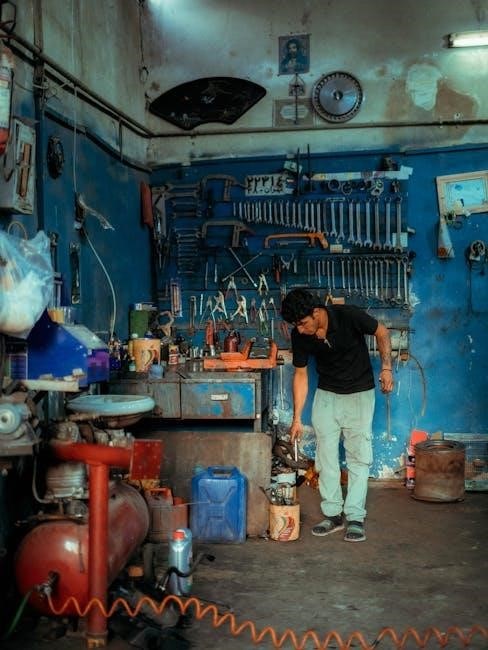
Overview of the 2016 Honda CR-V Maintenance Schedule PDF
The 2016 Honda CR-V maintenance schedule PDF provides a detailed guide for routine servicing‚ outlining tasks like oil changes and tire rotations at key mileage intervals.
2.1 Key Mileage Intervals for Scheduled Maintenance
The 2016 Honda CR-V maintenance schedule outlines key intervals at 15‚000‚ 30‚000‚ 45‚000‚ 60‚000‚ 90‚000‚ and 105‚000 miles. These milestones ensure timely checks and replacements‚ such as oil changes‚ tire rotations‚ and brake inspections‚ to maintain optimal vehicle health and performance. Adhering to these intervals helps prevent potential issues and ensures the longevity of your CR-V.
2.2 Importance of Regular Maintenance for Optimal Performance
Regular maintenance is essential for ensuring your 2016 Honda CR-V performs at its best. It prevents mechanical issues‚ enhances safety‚ and improves fuel efficiency. Neglecting routine checks can lead to costly repairs and reduced reliability. By following the recommended schedule‚ you protect your investment‚ maintain optimal performance‚ and ensure your vehicle remains safe and efficient for years to come.
Oil Change and Filter Replacement Guidelines
Regular oil changes and filter replacements are crucial for your 2016 Honda CR-V’s engine health. Follow the recommended schedule to prevent damage and ensure optimal performance.
3.1 Recommended Oil Type and Change Intervals
The 2016 Honda CR-V requires 0W-20 synthetic oil for optimal performance. Oil changes are recommended every 7‚500 miles or 6 months‚ whichever comes first. This ensures engine longevity and maintains fuel efficiency. Always use the grade specified in your owner’s manual to prevent damage. Severe driving conditions may require more frequent changes. Regular oil changes are essential for keeping your vehicle running smoothly and preventing costly repairs.
3.2 Consequences of Neglecting Oil Changes
Neglecting oil changes in your 2016 Honda CR-V can lead to severe engine damage‚ increased wear on moving parts‚ and reduced fuel efficiency. Sludge buildup in the engine can clog vital components‚ causing costly repairs. Over time‚ this can result in complete engine failure‚ requiring expensive replacements. Regular oil changes are essential to maintain engine health‚ performance‚ and longevity‚ ensuring your vehicle runs smoothly for years to come.
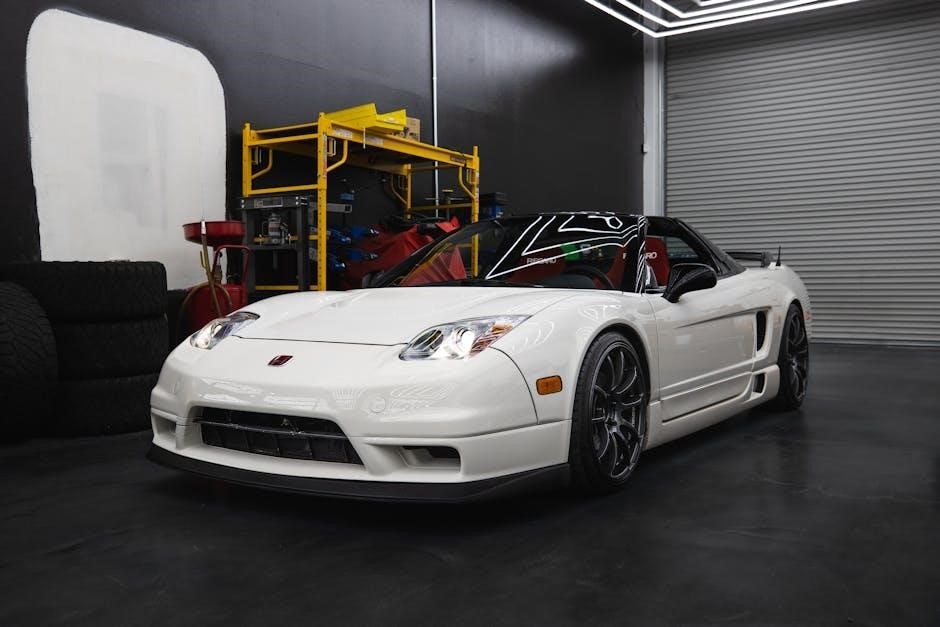
Tire Rotation and Inspection Schedule
Neglecting oil changes in your 2016 Honda CR-V can lead to engine damage‚ increased wear on moving parts‚ and reduced fuel efficiency. Sludge buildup clogs components‚ causing costly repairs. Regular oil changes are essential to maintain engine health‚ performance‚ and longevity‚ ensuring your vehicle runs smoothly for years to come.
4.1 Recommended Tire Rotation Patterns
The 2016 Honda CR-V recommends tire rotation every 7‚500 miles or six months. Patterns include rearward cross‚ forward cross‚ and side-to-side. Regular rotation ensures even tread wear‚ improves handling‚ and extends tire life. Proper rotation enhances safety and traction‚ while uneven wear can lead to premature replacement. Always refer to the owner’s manual for specific patterns and guidelines tailored to your vehicle’s needs and driving conditions.
4.2 Signs of Uneven Tire Wear and Solutions
Uneven tire wear on the 2016 Honda CR-V may appear as uneven tread patterns‚ feathering‚ or cupping. These issues often result from improper tire rotation or misaligned wheels. Regular inspections can identify these signs early. Solutions include following the recommended tire rotation patterns‚ checking wheel alignment‚ and ensuring proper tire pressure. Addressing uneven wear promptly prevents further damage and extends tire life‚ ensuring safety and optimal vehicle performance.
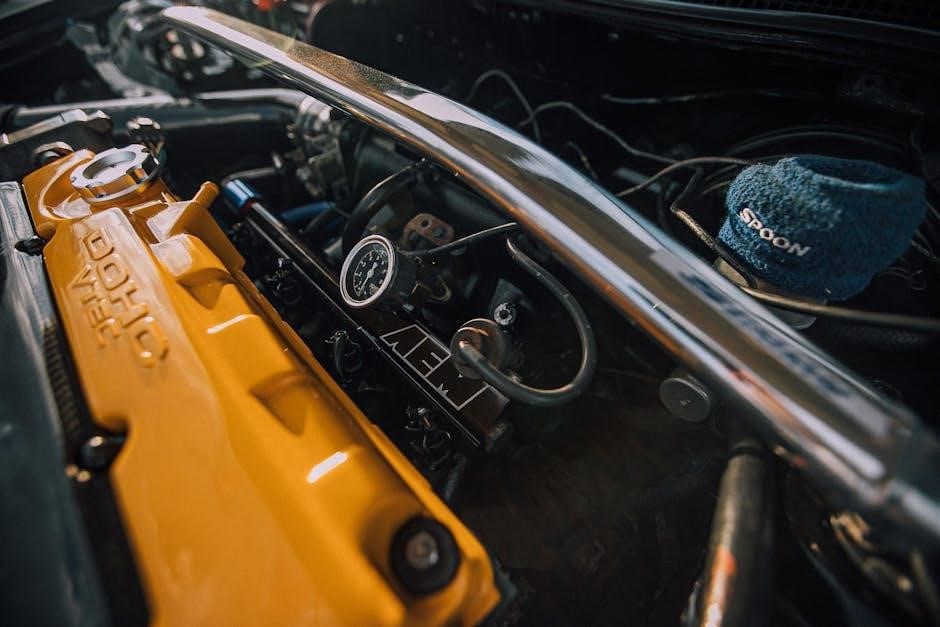
Brake System Inspection and Maintenance
Regular brake system inspections are crucial for the 2016 Honda CR-V’s safety and performance. Inspect brake pads‚ rotors‚ and fluid levels every 7‚500 miles or six months for optimal functionality.
5.1 Frequency of Brake Pad and Rotor Inspections
Brake pad and rotor inspections for the 2016 Honda CR-V are recommended every 7‚500 miles or six months; During these checks‚ technicians assess pad thickness‚ rotor condition‚ and signs of wear. Excessive wear or damage necessitates immediate replacement to maintain safe braking performance. Regular inspections prevent costly repairs and ensure reliable stopping power‚ aligning with the manufacturer’s guidelines for optimal vehicle safety and functionality.
5.2 Importance of Brake Fluid Level and Condition Checks
Checking the brake fluid level and condition is vital for the 2016 Honda CR-V. Brake fluid absorbs moisture over time‚ which can lower its boiling point and reduce braking efficiency. Honda recommends flushing brake fluid every three years to prevent corrosion and maintain optimal performance. Regular checks ensure proper braking response and safety. Always consult your owner’s manual or a certified technician for accurate service intervals and procedures to guarantee reliable braking system function.

Fluid Changes and Flushes
Regular fluid changes and flushes are essential for the 2016 Honda CR-V. This includes transmission‚ brake‚ and coolant fluids to ensure optimal performance and prevent system damage. Schedule these services as recommended in your owner’s manual to maintain your vehicle’s health and reliability.
6.1 Transmission Fluid Replacement Recommendations
Transmission fluid replacement for the 2016 Honda CR-V is recommended around every 90‚000 miles or as specified in the maintenance schedule. This interval may vary based on driving conditions‚ such as frequent towing or stop-and-go traffic. Using the correct type of fluid is crucial to ensure smooth transmission operation and prevent damage. Always consult the owner’s manual or a certified technician for precise guidelines and to avoid potential transmission issues. Regular replacement helps maintain optimal performance and extends the life of your vehicle’s transmission system.
6.2 Brake Fluid Flush Intervals and Safety Implications
Honda recommends flushing the brake fluid in your 2016 CR-V every three years‚ regardless of mileage‚ to ensure optimal braking performance. Brake fluid absorbs moisture‚ which can lower its boiling point and increase the risk of brake failure. Contaminated fluid can cause corrosion and reduce braking effectiveness‚ leading to dangerous situations. Regular flushes by a qualified technician are critical for maintaining safety and reliability‚ ensuring your vehicle’s brakes function properly when needed most.
6.3 Coolant Replacement and Its Role in Engine Health
Coolant replacement is essential for maintaining your 2016 Honda CR-V’s engine health. Over time‚ coolant degrades‚ reducing its ability to protect against overheating and corrosion. Honda recommends replacing the coolant at specified intervals‚ typically around 90‚000 miles‚ to ensure proper engine temperature regulation. Regular coolant flushes prevent damage to the radiator‚ water pump‚ and engine components‚ safeguarding your vehicle’s performance and longevity while preventing costly repairs due to overheating.

15‚000-Mile Service Details
The 15‚000-mile service for the 2016 Honda CR-V includes an engine air filter replacement and a comprehensive vehicle inspection to ensure optimal performance and identify potential issues early.
7.1 Engine Air Filter Replacement
Replacing the engine air filter at the 15‚000-mile mark is essential for maintaining your 2016 Honda CR-V’s performance and fuel efficiency. A dirty air filter can restrict airflow‚ reducing engine power and gas mileage. Honda recommends using a high-quality filter that meets OEM specifications. Regular inspections and replacements ensure optimal engine health. Refer to your owner’s manual for exact intervals‚ as driving conditions may require more frequent changes. Clean air intake is crucial for peak performance.
7.2 Comprehensive Vehicle Inspection Checklist
The 15‚000-mile service includes a thorough inspection of your 2016 Honda CR-V. This checklist covers brakes‚ belts‚ hoses‚ suspension‚ and exhaust systems. Technicians check for wear on brake pads‚ condition of drive belts‚ and fluid levels. They also inspect the suspension and steering components for alignment and damage. Ensuring all systems are in good condition helps prevent unexpected issues and maintains your vehicle’s reliability and performance on the road.
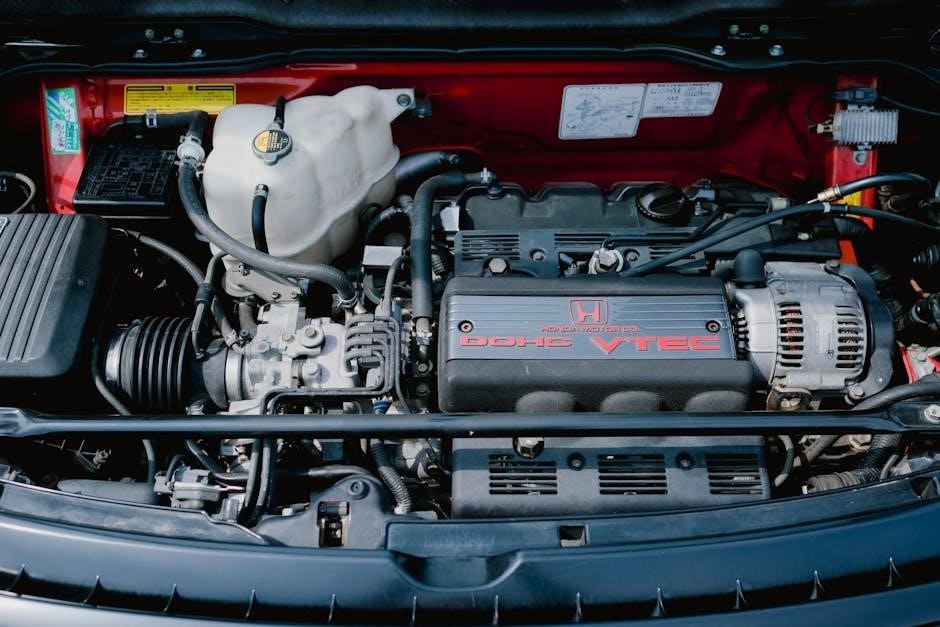
30‚000-Mile Service Highlights
The 30‚000-mile service for your 2016 Honda CR-V includes replacing the cabin air filter and inspecting the drive belt. These tasks ensure improved air quality and belt longevity‚ enhancing overall vehicle performance and comfort.
8.1 Cabin Air Filter Replacement
Replacing the cabin air filter at the 30‚000-mile service ensures clean air circulation inside your 2016 Honda CR-V. This filter traps dust‚ pollen‚ and odors‚ improving air quality for passengers. Over time‚ a clogged filter can reduce airflow and efficiency. The recommended interval for replacement is typically every 15‚000 to 30‚000 miles‚ depending on driving conditions. A fresh filter enhances comfort‚ reduces allergens‚ and prevents unpleasant odors‚ keeping your cabin environment fresh and healthy.
8.2 Drive Belt Inspection and Tension Check
The drive belt inspection and tension check at the 30‚000-mile service ensures proper operation of essential engine components like the alternator and AC compressor. Cracks‚ wear‚ or misalignment can lead to belt failure‚ causing breakdowns. Inspect for signs of damage or excessive wear and adjust tension as needed. Regular checks prevent sudden failures and maintain reliable engine performance. Always refer to the owner’s manual for precise guidelines.
45‚000-Mile Service Requirements
The 45‚000-mile service is a key maintenance milestone for your 2016 Honda CR-V. It includes spark plug replacement and a detailed fuel system inspection to ensure optimal engine performance and efficiency. Consulting the maintenance schedule PDF provides specific guidelines for these critical services.
9.1 Spark Plug Replacement
Spark plug replacement is recommended at the 45‚000-mile service for your 2016 Honda CR-V. Worn spark plugs can cause poor engine performance‚ reduced fuel efficiency‚ and potential misfires. The procedure involves removing the old plugs and installing new ones‚ ensuring proper combustion and engine efficiency. Always use spark plugs specified in the maintenance schedule PDF for optimal performance. Proper installation by a certified technician is advised to avoid engine damage and ensure reliability. This service is crucial for maintaining your vehicle’s overall health and performance.
9.2 Fuel System Inspection and Cleaning
The fuel system inspection and cleaning for your 2016 Honda CR-V is typically performed during the 45‚000-mile service. This process involves checking for blockages‚ corrosion‚ and damage in the fuel lines and injectors. Cleaning ensures proper fuel flow and prevents engine issues like poor performance or decreased fuel efficiency. Regular inspections help maintain optimal engine health and prevent costly repairs. A clean fuel system is essential for reliable operation and long-term vehicle performance.

60‚000-Mile Service Overview
The 60‚000-mile service includes a thorough inspection of the suspension and steering systems‚ along with battery terminal cleaning and a charge check to ensure optimal performance and reliability.
10.1 Battery Terminal Cleaning and Charge Check
The 60‚000-mile service includes a detailed inspection of the battery terminals to ensure proper electrical connections. Cleaning the terminals prevents corrosion buildup‚ which can disrupt power flow. A charge check verifies the battery’s health‚ ensuring reliable starting and accessory operation. This maintenance is crucial for preventing unexpected failures and maintaining consistent vehicle performance. Always refer to the 2016 Honda CR-V maintenance schedule PDF for precise guidelines. Regular checks extend battery life and overall electrical system efficiency.
10.2 Suspension and Steering System Inspection
The 60‚000-mile service includes a thorough inspection of the suspension and steering systems. Key components like ball joints‚ tie rod ends‚ and bushings are checked for wear or damage. This ensures stable handling and safety. Any signs of excessive wear are addressed promptly to prevent alignment issues or loss of control. The inspection also verifies proper steering responsiveness and suspension performance. Refer to the 2016 Honda CR-V maintenance schedule PDF for detailed procedures.
90‚000-Mile Service Checklist
The 90‚000-mile service includes a detailed inspection and critical replacements‚ such as the timing belt and transmission fluid. This ensures optimal performance and prevents costly repairs.
11.1 Timing Belt Replacement
The timing belt replacement at 90‚000 miles is critical for the 2016 Honda CR-V. This belt synchronizes the engine’s crankshaft and camshaft‚ preventing costly damage if it fails. Replacing it proactively avoids engine repairs‚ ensuring reliability and performance. Always use genuine parts and have it done by a certified technician to maintain warranty and engine health. Regular inspection and timely replacement are essential.
11.2 Transmission and Differential Fluid Change
Changing the transmission and differential fluids at 90‚000 miles is essential for the 2016 Honda CR-V. These fluids lubricate gears and bearings‚ ensuring smooth operation. Over time‚ they degrade‚ losing their effectiveness. Neglecting this can lead to reduced performance and increased wear on components. Always use the correct fluid type and consult your owner’s manual for precise intervals. A certified technician can perform this service to maintain optimal drivetrain health and prevent costly repairs.
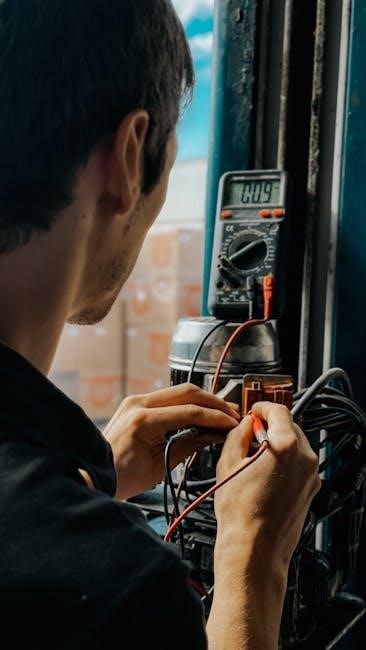
105‚000-Mile Service Highlights
The 105‚000-mile service includes an engine performance check and tune-up‚ ensuring optimal operation. An exhaust system inspection is also performed to identify potential issues early‚ maintaining reliability and efficiency.
12.1 Engine Performance Check and Tune-Up
The 105‚000-mile service includes a thorough engine performance check and tune-up. This involves inspecting spark plugs‚ fuel injectors‚ and the ignition system. Technicians ensure proper air-fuel mixture‚ address any misfires‚ and replace worn components. The engine is also checked for leaks and vacuum issues. A tune-up optimizes power‚ fuel efficiency‚ and reduces emissions‚ ensuring the engine runs smoothly. Regular tune-ups prevent major repairs and maintain peak performance.
12.2 Exhaust System Inspection
The 105‚000-mile service includes a detailed inspection of the exhaust system to ensure efficiency and safety. Technicians check for leaks‚ damage‚ or corrosion in the muffler‚ catalytic converter‚ and exhaust pipes. Any issues are addressed to prevent emissions problems or performance loss. Regular inspections help maintain proper engine function and reduce the risk of costly repairs. A well-maintained exhaust system ensures optimal performance and reliability‚ aligning with the maintenance schedule’s goals.

Additional Maintenance Items
Additional maintenance items for the 2016 Honda CR-V include wiper blade replacement and headlight cleaning to ensure optimal visibility‚ safety‚ and prevent potential damage from worn parts;
13.1 Wiper Blade Replacement
Wiper blade replacement is essential for maintaining clear visibility. Blades should be replaced every 6 to 12 months or when showing signs of wear‚ such as streaks or noise. Inspect for cracks or damage regularly. Proper replacement ensures optimal performance and safety during rainy or dusty conditions. Always use genuine Honda parts for compatibility and reliability. Regular checks prevent worn blades from impairing your view while driving.
13.2 Headlight and Taillight Cleaning
Regular cleaning of headlights and taillights is crucial for maintaining visibility and safety. Use a soft cloth and mild soap to remove dirt and grime. Avoid abrasive materials that may scratch the surfaces. Clean during routine car washes or when noticeable buildup occurs. For foggy or hazy lenses‚ consider using specialized cleaning products or polishes. Proper maintenance ensures clear illumination and enhances your vehicle’s overall appearance and functionality on the road.
Understanding the Maintenance Minder System
The Maintenance Minder System tracks your vehicle’s maintenance needs‚ providing reminders for oil changes‚ tire rotations‚ and other services. It eliminates the need for a separate maintenance planner‚ ensuring you stay on schedule effortlessly.
14.1 How the System Tracks Maintenance Needs
The Maintenance Minder System uses sensors and mileage tracking to monitor your vehicle’s condition. It calculates oil degradation‚ tire wear‚ and other factors to determine when service is needed. Alerts are displayed on the dashboard‚ ensuring timely reminders for oil changes‚ tire rotations‚ and fluid checks. This intelligent system helps prevent overdue maintenance‚ protecting your vehicle’s health and performance.
14.2 Resetting the Maintenance Light After Service
After completing the recommended maintenance‚ reset the Maintenance Minder System to clear the service light. Use the steering wheel-mounted controls to navigate to the instrument cluster settings. Select the maintenance reset option and follow the prompts to complete the process. Properly resetting the system ensures accurate tracking of future service needs. Refer to your owner’s manual for precise steps‚ as improper resetting can lead to incorrect reminders.
Importance of Adhering to the Schedule
Adhering to the 2016 Honda CR-V maintenance schedule prevents costly repairs‚ ensures safety‚ and promotes reliability. Regular servicing maintains optimal performance and extends vehicle longevity‚ avoiding potential issues down the road.
15.1 Preventing Costly Repairs
Adhering to the 2016 Honda CR-V maintenance schedule helps prevent costly repairs by addressing issues early. Regular checks and replacements‚ such as oil changes and brake inspections‚ reduce wear and tear. Proactive servicing identifies potential problems before they escalate‚ saving money and extending vehicle life. Neglecting routine maintenance can lead to major repairs‚ making consistent adherence to the schedule a financially sound decision for long-term vehicle health and performance.
15.2 Ensuring Safety and Reliability
Regular maintenance ensures the safety and reliability of your 2016 Honda CR-V. By following the schedule‚ you prevent potential hazards like brake failure or engine issues. Services such as brake fluid flushes and oil changes maintain critical systems‚ reducing the risk of breakdowns. A well-maintained vehicle performs optimally‚ ensuring safer driving conditions and protecting both passengers and other road users from avoidable risks.
Adhering to the 2016 Honda CR-V maintenance schedule ensures optimal performance‚ safety‚ and reliability. Regular servicing prevents costly repairs and extends the vehicle’s lifespan‚ keeping it running smoothly for years.
16.1 Summary of Key Maintenance Points
The 2016 Honda CR-V maintenance schedule emphasizes regular oil changes‚ tire rotations‚ and brake inspections to ensure longevity. Key services at 15‚000‚ 30‚000‚ 45‚000‚ and 60‚000 miles include air filter replacements‚ belt inspections‚ and fluid flushes. Spark plug and timing belt replacements at higher mileages are critical for engine health. Adhering to this schedule prevents costly repairs‚ ensuring optimal performance‚ safety‚ and reliability for years to come.
16.2 Final Tips for Vehicle Longevity
Consistently follow the maintenance schedule to maximize your Honda CR-V’s lifespan. Address any issues promptly to prevent minor problems from escalating. Use genuine parts and fluids to ensure compatibility and performance. Regularly inspect belts‚ hoses‚ and air filters for wear. Keep your vehicle clean‚ inside and out‚ to prevent rust and maintain comfort. Drive responsibly to reduce wear on brakes and tires. Always refer to your owner’s manual for guidance.